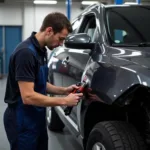Blending car paint during a repair is a crucial step that can make or break the final result. A seamless blend makes the repair invisible, while a poor one can stick out like a sore thumb. This guide covers everything you need to know about how to blend in car paint repair, from understanding the basics to mastering advanced techniques.
Learning how to blend paint correctly not only improves the aesthetics of your car but also helps maintain its value. A professional-looking repair job demonstrates attention to detail and can be a major selling point. Whether you’re dealing with a minor scratch or more extensive damage, understanding the art of blending is essential for achieving a flawless finish. Check out our guide on blend paint repair car for a quicker overview of the process.
Understanding the Basics of Car Paint Blending
Blending involves gradually fading the newly applied paint into the surrounding original paintwork. This creates a smooth transition that minimizes any noticeable difference in color or texture. The key is to create an imperceptible gradient, making the repair virtually invisible. This requires careful preparation, precise application, and a deep understanding of color matching.
Why is Blending Necessary?
Even with perfect color matching, slight variations in the paint can occur due to factors like fading, weathering, and the manufacturing process itself. Blending helps to compensate for these variations, ensuring a uniform finish across the entire panel.
Tools and Materials for Blending
- Matching Paint: Obtaining the correct paint code for your car is paramount. This code specifies the exact factory color and allows for precise mixing.
- Spray Gun: A high-quality spray gun is essential for achieving a fine, even coat of paint.
- Sandpaper: Various grits of sandpaper are needed for preparing the surface and feathering the edges of the repair area.
- Masking Tape and Paper: These are crucial for protecting the surrounding areas from overspray.
- Blending Solvent: This helps to soften the clear coat and promote a seamless blend.
- Polishing Compounds: These are used to refine the finish and remove any imperfections.
Preparing the Repair Area
Thorough preparation is critical for successful blending. The surface must be clean, smooth, and free of any contaminants. Start by thoroughly cleaning the area with a wax and grease remover. Then, sand the damaged area and feather the edges to create a smooth transition zone for blending. For more specific instructions on blending techniques, you might find our guide on car repair paint blending helpful.
Feathering the Edges
Feathering involves gradually thinning the edges of the clear coat surrounding the repair area. This creates a ramp-like effect that allows the new paint to blend seamlessly with the existing finish. This step is crucial for avoiding a harsh line between the repaired and original paint.
Applying the Paint and Clear Coat
Apply several thin coats of base coat, allowing each coat to dry before applying the next. Once the base coat is dry, apply the clear coat, extending it slightly beyond the feathered edge. This overlapping application of clear coat is key to achieving a smooth, blended finish. Learn more about blending techniques in our article on car paint repair blending.
Blending and Finishing
After the clear coat has dried, use fine-grit sandpaper to level any imperfections. Then, use polishing compounds to refine the finish and restore the gloss.
Wet Sanding and Polishing
Wet sanding and polishing are essential for achieving a professional-looking repair. Wet sanding helps to level the clear coat and remove any orange peel or dust nibs. Polishing restores the shine and brings out the depth of the color.
“Proper blending is not just about technique; it’s about patience and attention to detail,” says John Smith, a veteran auto body repair specialist with over 20 years of experience. “Taking your time and focusing on each step will ultimately yield the best results.”
Conclusion
Blending car paint requires practice and attention to detail. By understanding the principles and following the steps outlined in this guide, you can achieve professional-looking results and maintain your car’s appearance. For further guidance on how to blend a paint repair on your car, visit our dedicated page: how to blend a paint repair on car. Remember, proper blending is essential for any car paint repair and can make a significant difference in the overall quality of the job.
FAQ
-
What is the most important step in blending car paint? Accurate color matching and meticulous surface preparation are crucial.
-
Can I blend car paint without a spray gun? While possible with aerosol cans, achieving a professional finish is significantly more challenging.
-
How long does it take for the paint to dry? Drying times vary depending on the type of paint and environmental conditions.
-
What if I make a mistake during the blending process? Minor errors can often be corrected with wet sanding and polishing.
-
Is blending necessary for all car paint repairs? Blending is generally recommended for most repairs to ensure a seamless and invisible fix.
-
How can I prevent overspray when blending car paint? Proper masking and controlling the spray pattern are key to preventing overspray.
-
What is the difference between blending and fading? Blending refers to seamlessly integrating the new paint with the existing finish, while fading is a technique used to create a gradual transition between two different colors.
You may also want to check out our guide on rep-paint car door for information on repainting a car door.
Need help with your car repair? Contact us via WhatsApp: +1(641)206-8880 or Email: [email protected]. Our 24/7 customer support team is ready to assist you.

